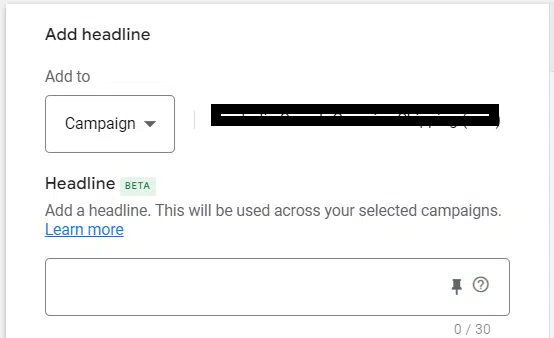While Google’s responsive search ads (RSAs) have come a long way from the simple text ads of the past, there are still plenty of opportunities to optimize and take your PPC performance to new heights.
Let’s dive into seven proven strategies that can help you elevate your Google responsive search ads game.
1. Less is sometimes more
We’re starting with a concept rather than a feature here, but just because you can add 15 headlines and four descriptions doesn’t mean you should also populate all of those slots. A few reasons why:
- You could be diluting the key USPs with filler content, just so the ad strength improves (not a quality indicator).
- So often, you try to scrap the website content in a desperate attempt to reach title double figures.
- However, the more copy added, the less your primary messaging will be shown. Always aim for quality over quantity and resist Google’s pressure to add more.
- The more titles/descriptions used in an RSA, the more ad variations there are for Google’s algorithm to use.
- That’s all well and good for campaigns and ad groups that have big budgets and big volumes.
- Still, for small campaigns with smaller keyword demands, Google and Bing (especially Bing) won’t have enough impressions to run all the possible ad variations enough times for a conclusive result.
- Learning periods will be ongoing and performance insights will be limited. Do you ever check the ad asset report for an RSA and see “pending”? This is why.
- Less titles and descriptions can also give you better scope to do manual testing, as there are fewer variations in play.
- As the above point applies to Google automation testing, it applies to the A/B tests we carry out, which we will go into more detail shortly.
2. Keyword insertion
This is a really useful way of making your ads more relevant and improving your quality score. When applied, Google will populate the RSA with whatever keyword your search term triggered the ad for.
You can also add copy before and after the keyword insertion to tailor the message. For example:
- Your title could read “Buy {keyword insertion: {Nike Running Shoes} Today.”
- The keyword will appear between “Buy” and “Today.”
If the keyword triggered pushes the character limit over, Google will use the fallback copy you included, “Nike running shoes” in the above example.
It should not be used in every circumstance, as it can get messy when overused. And you are in danger of the ad not reading right.
This is especially true in consolidated ad groups with more keywords. Less control with more keywords eligible to appear in the keyword insertion.
Extra word of caution: Never use this for competitor keyword campaigns.
3. Countdown insertion
This is a really cool feature and an absolute essential for your sale or event ads. Including a countdown timer is such an effective way to add urgency to your RSAs.

You can customize how many days in advance you’d like the timer to begin. As with the keyword insertion feature, you can include copy before and after insertion. For example:
- “Sale Ends in {countdown yyyy/mm/dd}.”
Even when there is less than a day before the end of the countdown, Google tells you to the second how long you have left. Very eye-catching for users.
Get the daily newsletter search marketers rely on.
4. Ad pinning
Not happy with giving Google the control to put your copy in any order that suits them? Well, then pinning is the answer.
This allows you to tell Google what title and description you want to remain constant in your ad and in which position. You can also pin multiple headlines and descriptions in the same position, which Google will alternate.
Your ad strength will suffer using pins, as Google doesn’t like not being in control. But advertisers sometimes just need the ability to decide what order the copy goes in.
For example, putting your product in the first two titles (long name) and including the price as the final title is not ideal if Google decides to mix that order, even if the algorithm thinks it has a better CTR.
I’d recommend testing two RSAs at once for ad groups with high volume. Use the same copy, but one with pins and one without. Test yourself against the algorithm.
Remember, Google often prioritizes RSA variations based on CTR, but if the objective of the ads is conversion-based, then you should judge the results toward conversion rate, CPA or ROAS instead.
5. Ad experiments
As Google will often prioritize the best CTR performance in ads, if you are testing two RSAs in the same ad group, then they will quickly favor one and show it more often.
Experiments are what you want if you want a fairer, less biased testing framework.
The experiment feature can effectively test different keywords, landing pages, bid strategies, etc. Testing ads is another feather in its cap.

You can set up experiments to show each ad evenly at 50/50 over a selected time period (currently maxed out at 64 days). During setup, Google will duplicate your campaign into a test version. You make whatever changes to the RSA you need to, then just schedule a start ****.
Once the test begins, you can access a testing dashboard within the experiment tab that compares control and test campaigns.
When setting up the experiment, you will tell Google your two performance priorities, so the dashboard will focus its reporting on those metrics.
6. Campaign-level headline and description assets
This is the newest feature in the list and, as of this writing, is still in beta. It’s a great addition designed for use during a specific period (e.g., a sale or an event).
At the campaign level, you can schedule up to three headlines and two descriptions to appear in all of the campaign’s RSAs rather than updating all of your ads individually.
If messaging is a priority, you can also pin these extra assets and schedule a start and end ****.

They are ideal for large Search accounts with a high volume of RSAs that require frequent copy changes to highlight promotional periods.
What could’ve taken hours to regularly update, schedule and revert back to the original copy now takes only a few minutes. Preparing for Black Friday might not seem as daunting this year.
7. Ad variations
This is probably the most underutilized feature for RSA ads. Experiments are the most common A/B testing framework. Still, if you want to test specific titles or descriptions against other variants (as opposed to RSA vs. RSA), this is the ideal solution.
This is very cool for creating tests at a forensic level. If you have a legacy USP scattered across multiple RSAs (e.g., “Free Shipping Available”) but are thinking of replacing it with a similar but refreshed take (e.g., “Free shipping when you spend over $50”), then you simply select the “Find & Replace” variation type, input the original copy and replace with the new.
Just like setting up experiments, you select the start and end ****, how much the experiment split is (which for me is always 50%) and then create. There are other types of ad variations that can update whole headlines and descriptions, as well as URLs, but I would use find and replace more commonly.
What about AI content?
I couldn’t go through the whole article without mentioning the hottest industry topic: AI. So, I thought it deserved its own bonus section.
Now, the truth is that the practical application of AI for RSAs lies outside of the advertising platform (Performance Max asset group copy is a different story with the new generative AI feature).
One of the first PPC use cases of ChatGPT, when it came on the scene, was generating additional and alternative creative for RSAs based on expanding the existing copy.
The danger is being too reliant on AI for content. Yes, ChatGPT, Gemini and the rest are great tools for carrying the creative burden. However, using AI to create the majority of the copy can lead to generic output or even a separation away from the brand identity if your prompt engineering isn’t up to scratch.
To strive toward compelling ad copy, simplicity is often the best method, so try not to overcomplicate the process. I’ve found the best use is identifying the best-performing titles and descriptions (hopefully, most of the ad asset report data isn’t pending, so you can see these insights) and using AI to expand and enhance the poor performers with alternative variations.
Lean on AI and use it to generate fresh ideas, but don’t rely on it. Remember, you will know the brand and the USPs better than AI. Humans still have a use, after all.
Opinions expressed in this article are those of the guest author and not necessarily Search Engine Land. Staff authors are listed here.
Source link : Searchengineland.com
